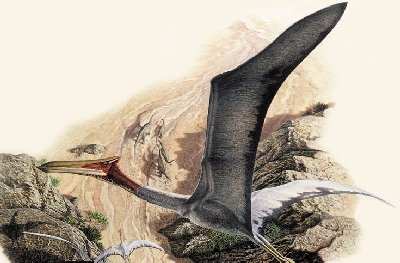

The flying reptile was called “one of the greatest freaks of all time” by the late Harvard professor Percy Raymond. The flight mechanism was bat-like rather than bird-like. A membrane of skin stretched from the trunk to the front limb, but was attached to a greatly elongated fourth finger of the hand, and not to all four fingers as with a bat. Flying reptiles were probably soarers and gliders rather than active flyers. They could fold their wings like bats, and may have had similar roosting habits.
Until recently, it was thought that a wingspan of about 24 feet was the maximum size, for one of these winged lizards. Then in 1971, Douglas Lawson, a University of Texas student, discovered the fossil bones of an even larger specimen, with a wingspan of 36 to 39 feet. It was named after the Aztec god who looked like a feathered serpent: Quetzalcoatlus northropi. Pronounced “kwet zel KWAT lus,” this creature was one of the last of the pterosaurs to survive. Its neck was extremely long, its slender jaws were toothless, and its head was topped by a long bony crest. Like other pterosaurs, it had fingers on the front edge of its wing with sharp claws that could grip prey.
The eating habits of Quetzalcoatlus are unknown, and there are different theories about the feeding habits of flying reptiles. Some experts think they ventured far out to sea, skimming over the surface of the water, and skillfully fed on fish. Others think they may have been carrion feeders, like modern vultures, and fed upon the carcasses of dinosaurs. Their long beaks and necks made them capable of probing deeply for food, on sea or land.
Aeronautical engineers and paleontologists have theories about how large animals launched themselves into space and stayed there. As a flying machine Quetzalcoatlus lacked the muscle power to run rapidly until it reached an airspeed that allowed it to take off. Likewise, it did not have the muscle or skeletal structure to flap its wings constantly to maintain flight. Perhaps it became airborne by dropping from the height of a cliff, or the crest of a wave. Or perhaps it waited until the hot sun warmed the ground and created strong thermal updrafts. Maybe it could stand up on its hind legs and catch an appropriate breeze, and with a single flap of its wings and a kick of its feet become airborne. Once aloft, it may have stayed in the air for long periods, riding air currents with minimal effort as it soared slowly and gracefully over land or water looking for prey. Its aeronautical design suggests that it could coast more slowly than a bird, before it stalled and had to land. The great wings may have allowed it to land gently, but its size, weight and long, weak hind limbs suggest that it did not live in trees as birds do.
Flying reptiles became extinct about the same time that dinosaurs did,
at the close of the Age of
Reptiles, or the Mesozoic Era. Even as they reached new records of
size, a changing geography and their failure to adapt to new environments
doomed pterosaurs. The Inland Sea, which covered so much of the interior
of North America, drained away, and similar events around the globe affected
the climate and food supply. Birds were better suited to flight and
adapting for survival in almost every way, and became increasingly diversified.
Dinosaur Hall already displays a good model of another flying lizard,
Pteranodon, sitting high on the wall by Tyranosaurus rex, with its wings
folded. This creature had a wingspan of about 12 feet, and for many years
it was considered the largest animal that ever flew.
The incredibly light and thin-walled bones of large flying reptiles
are rare discoveries in the fossil record. Crushed deep in the Earth by
the pressures of overlying sediments, they are less likely to survive than
dinosaur bones from the same deposits, and tend to be fragmentary and
badly shattered.
Thus the model of Quetzalcoatlus in Dinosaur Hall is a composite of bones from several individuals, with some parts consisting of enlarged replicas made from casts of smaller specimens. The original fossils are too rare to be incorporated in the exhibit. Paleontologists at the University of Texas, Austin, including an expert on this species, professor Wann Langston, Jr., have worked with Carnegie Museum experts to produce an original display—the first ever made of Quetzalcoatlus. Matt Smith, an experienced maker of dinosaur fossil molds in Montana, replicated the bones for the display. The skeleton of the creature will be seen dramatically within an outline or shell of its entire body.
When mounted above the second balcony in Dinosaur Hall, the flying reptile will span the hall from side to side. Its sensational presence above the dinosaurs themselves will make the hall an even more dramatic experience for visitors. Curator Mary Dawson notes that this is another “first” for Pittsburgh’s famous Dinosaur Hall.
—R. Jay Gangewere
Contents |
Highlights |
Calendar |
Back Issues |
Museums |